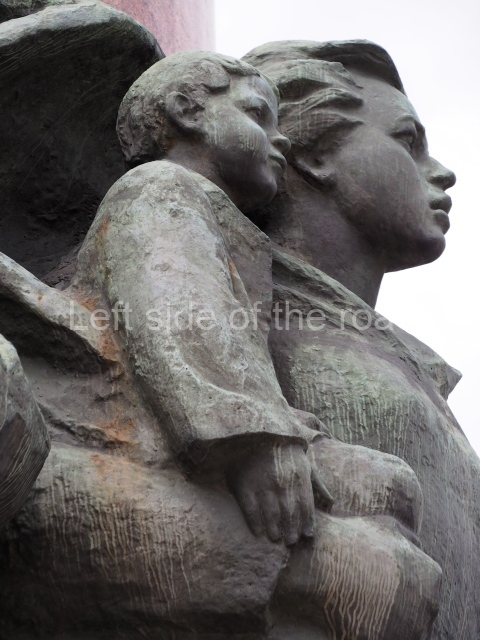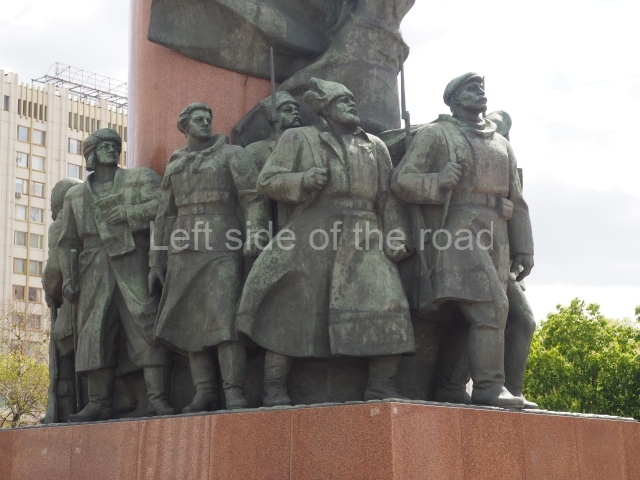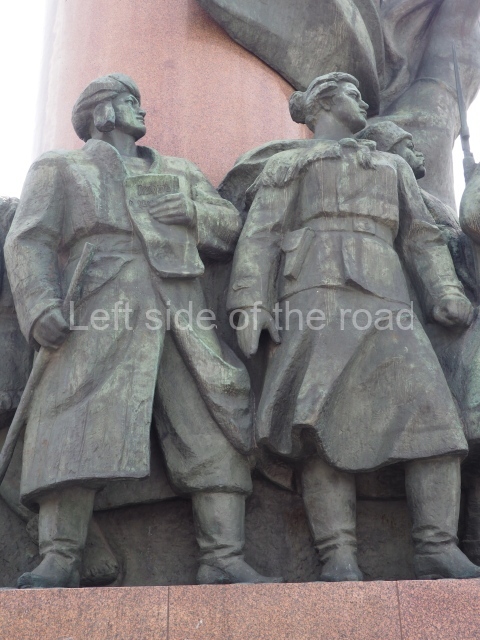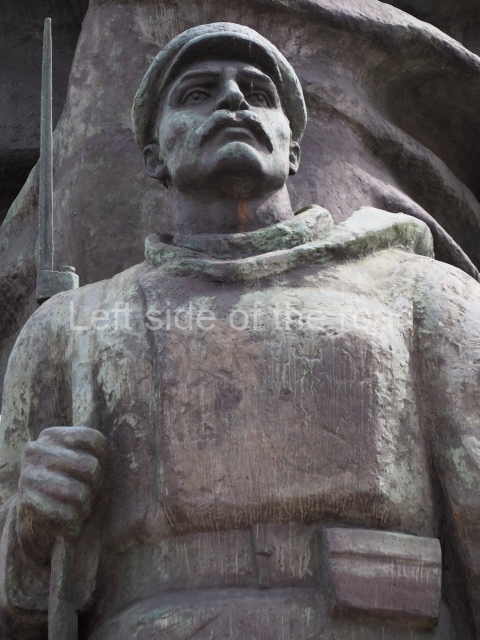
Lenin, Stalin and Dzerzhinsky at the Smolny
More on the ‘Revolutionary Year’
More on the USSR
The Centenary of the October Revolution of 1917
The centenary of the most important event in the history of the world occurs on the 7th November 2017. On that day a hundred years ago the working class and peasantry of Russia took power into their own hands and attempted to build a new world order.
I have already looked at that event in another, earlier post, but as we live in a world that is obsessed with anniversaries (and I’m falling into that trap, being in Leningrad at the time of the centenary) perhaps it’s time to re-address the issues that were brought up by that tremendous, earth shattering event.
We can gauge the magnitude of the events in that year by the way capitalism did it’s best to destroy the nascent Soviet state.
Lenin – the leader of the Bolsheviks – together with James Connolly of the Irish Republican Army, were the only socialist leaders to condemn the slaughter of the First World War as soon as it started. Social democratic apologists for capitalism (such as the British Labour Party) reneged on their declarations against war (made at Stuttgart and Basel in 1907 and 1912 respectively) as soon as they were put to the test. Only the true Communists had kept to their principles and the imperialist countries knew they were dealing with a dangerous proletarian force when Lenin was at the head of the revolutionary party.
The capitalist countries saw red and realised that the Bolshevik Revolution was like no other that had preceded it. What the Parisian workers had attempted to achieve, in the Paris Commune of 1871, had been suppressed with the wholesale slaughter of tens of thousands of men, women and children. Capitalism would go to the same extremes to achieve a similar result in Russia. As the tools for this they used their pathetic, confused and ignorant workers (who had spent more four years killing each other for the benefit of their own oppressors) who were told to attack the first workers’ state. Like the sheep they had become they fed the resulting ‘Civil War’ when more people were killed than in the imperialist war itself.
The Revolution was celebrated by revolutionary workers all over the world as the harbinger of a new society, free from exploitation and oppression. A revolution ‘is not a dinner party’, as Chairman Mao said, and the ignorant, pusillanimous and forelock tugging workers and their collaborationist ‘Labour/Socialist’ parties have attacked and condemned the October Revolution for the necessary measures taken to defend, promote and develop the workers state on the road to build Socialism – and eventually Communism.
The road followed by the Soviet Union, alone, until joined by the People’s Republic of Albania in 1944, the People’s Republic of China in 1949, and much later, after an heroic battle against American Imperialism, the People’s Republic of Vietnam in 1975, was tortuous, long and hard.
Massive achievements were made – as well as mistakes. If a revolution is predictable it’s not a revolution. But what was achieved by the Soviet people, in the field of industrial production, the collectivisation of agriculture and the fearless, heroic and self-sacrifice that led to the defeat of the Nazi beast, was of immeasurable benefit to the people’s of the world – and a lesson which those exploited and oppressed of the world need to understand and emulate.
But those that inherit a revolution are not those who made it. They benefit from the achievements but want more – those ‘benefits’ of capitalism with which no socialist state can compete. And that’s things. Things like consumer goods, the fickle trinkets of mass production, that entice stupid people away from what is truly meaningful for a full and fruitful life – those necessities, like health, education and the ability to contribute to society through productive activity.
The revolution in the Soviet Union was lost in 1956 at the 20th Congress of the Communist Party of the Soviet Union (CPSU) where Nikita Khrushchev denounced Comrade Joseph Stalin and all the achievements of the previous 29 years and the period of Socialist construction in a sixth of the world’s land mass ended.
For a further 24 years the ‘Revisionist’ version of Communism promoted by the CPSU spread like a virus throughout the world, creating confusion and division within the working class. This was the task that had been taken on board by Social Democracy, after it’s betrayal of the working class in 1914 (by calling upon the workers in their respective countries to kill each other for the benefit of capitalism) but the Soviet renegades sowed more confusion by continuing to call themselves Communists and claiming to follow the revolutionary ideology of Marxism-Leninism. Their pathetic demise in 1991 was too long in coming.
A hundred years after the magnificent event (the images of which are more influenced by those who have seen the film’ October’ by the revolutionary Soviet director Sergei Eisenstein than what actually happened) the situation is very different.
Capitalism has been re-introduce in tooth and claw. Instead of free health, education, secure employment, pensions and an infrastructure that benefits the majority everything has now been privatised. The collective wealth created by Socialist workers has been stolen by opportunist thieves. One of these scumbag ‘oligarchs’ has a boat sitting of the coast of Turkey which is bigger than the Cruiser ‘Aurora’ that signalled the start of the attack on the Winter Palace and the virtual beginning of the Socialist Revolution.
(Perhaps it’s a sign of our times that a grand, ancient name has been given to a bunch of opportunist thugs and common thieves.)
But that’s the problem for the people of Russia of today. They are not the brave and courageous innovators of the past. Revolution is not passed down through the genes. They are the submissive, afraid and confused that populate most countries, especially those in the ‘so-called’ civilized ‘west’, Europe, North America and certain parts of the South-eastern Asia.
Putin plays the nationalist card, courts the church – of whatever denomination – in an attempt to maintain his power. After Khrushchev, Brezhnev, Andropov, Gobshite, and the Vodka Soaked Drunk Yeltsin, Putin is just a greedy opportunist who prays on civil society. After this bunch of cretins how can anyone, with a modicum of sense, criticise Uncle Joe’s policy of purging the Party of opportunist elements?
So no real celebration of the most important event in the history of the world in the place where it occurred.
That’s good.
Leningrad (it will always have that name to me), the cradle of the revolution, has been renamed St Petersburg (the Germanic name that was used before the First World War, and not even the Russified version of Petrograd) was where it all started 100 years ago. If there’s any ‘official’ attempt to recognise the event this is manifested in museum gallery exhibitions that seek to denigrate the success of the Bolsheviks rather than celebrate it.
Re-writing of history is the name of the game.
Denigration of the Socialist past is almost at a fascist level. Having had to suffer the ‘impartiality’ of the British media for so long, it’s quite refreshing to see a total ideological war against the past.
The Russian state has not decided to ignore the past – that would be impossible even in the present circumstances – rather they have chosen to re-interpret it.
Exhibitions in both Moscow and Leningrad at the end of 2017 that relate to the events of 1917 are a propaganda attempt to undermine the Revolution. In an effort to denigrate the importance of both Lenin and Stalin (as well as other truly revolutionary leaders) they promote Trotsky – if anyone was unsure of his counter-revolutionary nature the adoption of him as a ‘revolutionary icon’ by Putin’s state should clarify matters. (There was even an advert on Russian TV about a mini series around Trotsky’s life. He was considered a capitalist agent in the times of Socialism and he is becoming a ‘revolutionary’ icon by those who have been restoring total capitalist control of the country.)
For some reason, which I don’t really understand, Voroshilov has been added to the ‘devils’ of the past alongside JV Stalin. There’s obviously an agenda there but I’m not sure what. As with the so-called ‘rehabilitation’ of the traitors and foreign agents of the 1930s those who have been chosen by the present, capitalist regime are chosen for a reason – they are symbols of their aspirations.
This has been taken to bizarre extremes at times. At an exhibition in Leningrad, for example, in a section about propaganda (I don’t see this word as necessarily having a negative connotation) during the building of Socialism the information cards declare that the Soviet State only sought to eliminate illiteracy because this would make more people susceptible to brain washing Soviet propaganda.
The perfidious Communists were trying to out-do the obsfucators of the past, in Britain for example, who used Latin in the church and the courts so that the ordinary people wouldn’t be able to understand what was being said. By actually teaching them to read and write the Soviet ‘propaganda machine’ could be more easily absorbed by the basically ignorant workers and peasants. The double thinking here is remarkable.
Socialism goes contrary to all previous social systems based on class, exploitation and oppression. The most important aspect of the creation of a new kind of man and woman is the changing of the selfish mindset that is a close partner of class systems. This is the cultural revolution that all socialist societies have instituted in one form or another. Socialist values of collectivity and respect for all is an anathema to capitalism. Only an intellectually adept people are capable of building a society free from all the evils of the past.
Those in power in Russia today are quite happy to feed their population with the garbage that capitalism has to offer, from the likes of McDonald’s, KFC and Coca-Cola to the cheap, nasty and moronic TV shows copied from western Europe, the only difference being the language. Shit in,shit out.
If you placed these cretinous curators of exhibitions in a novel nobody would believe them credible.
But that’s not really an issue. The country has betrayed its revolutionary past. It has no right to claim the Revolution as its property as it’s people have rejected that revolution for a capitalist lifestyle – together with all the consequences of a capitalist society. If they complain about their present reality then they only have themselves to blame.
The present ‘Communist Party of the Russian Federation’ is more akin to the revisionist party that betrayed the Revolution than the Bolshevik Party of Lenin and Stalin. I wouldn’t trust them to change a light bulb let alone a country. They make token gestures to the event of a hundred years ago but chose to hold a meeting in Moscow at the exact time of the centenary. If nothing else they display no concept of history – something important for a revolutionary. If you don’t know, care or understand where you come from how can you know where to go in the future?
The people of St Petersburg walk the same streets as the revolutionaries but they don’t walk in their footsteps. The chances of them reversing the changes of the last 60 years are nil – unless the country has to confront another major crisis such as WWI. (But then they are no different from the workers of any other country where revolutions are only made when people are weak and in crisis rather than from positions of strength and stability.) If the lesson of the October Revolution is anything else it’s that we haven’t learnt the lessons of the October Revolution.
If the workers, peasants and poor of the world made a revolution when they wanted rather than waiting until it was a necessity then their future would be easier. They wait until the last moment and build the new from the literal ruins of the old rather than using the old as a foundation for the new.
Whether the centenary of the October Revolution will prompt the exploited and oppressed to look at their own situation anew is doubtful. But one thing is certain, for those who want to exert their own dignity the Great October Proletarian Revolution will remain a beacon which lights the future.
Long Live the Revolution of the 7th November 1917!
More on the ‘Revolutionary Year’
More on the USSR






















































